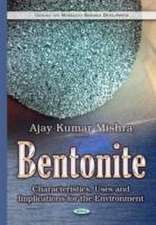Emerging and Nanomaterial Contaminants in Wastewater: Advanced Treatment Technologies
Editat de Ajay Kumar Mishra, Hossain Md Anawar, Nadjib Drouicheen Limba Engleză Paperback – 25 oct 2019
- Provides a fundamental understanding of emerging contaminants to help readers select appropriate remediation technologies
- Discusses, in detail, new and advanced green technologies that remove emerging contaminants from wastewater
- Shows how to ensure water quality and save public health by protecting water resources from contaminants
Preț: 956.50 lei
Preț vechi: 1254.84 lei
-24% Nou
Puncte Express: 1435
Preț estimativ în valută:
183.07€ • 188.67$ • 154.56£
183.07€ • 188.67$ • 154.56£
Carte tipărită la comandă
Livrare economică 24 februarie-10 martie
Preluare comenzi: 021 569.72.76
Specificații
ISBN-13: 9780128146736
ISBN-10: 0128146737
Pagini: 378
Dimensiuni: 152 x 229 x 25 mm
Greutate: 0.51 kg
Editura: ELSEVIER SCIENCE
ISBN-10: 0128146737
Pagini: 378
Dimensiuni: 152 x 229 x 25 mm
Greutate: 0.51 kg
Editura: ELSEVIER SCIENCE
Public țintă
(Post)-graduate students, researchers in academia and industry in chemical engineering and environmental science working on water and wastewater treatmentCuprins
Part 1: General Overview
1. What are the current emerging contaminants, types of nanomaterials, synthesis processes and reactors development?
2. An overview of treatment technologies for the removal of emerging and nanomaterial contaminants from municipal and industrial wastewater
Part 2: Green Technology
3. Transport and fate of the emerging compounds and their by-products in water environment, and their toxicity level: removal by natural process of flocculation, agglomeration, precipitation, colloid formation and sedimentation
4. Long-term performance and feasibility of using constructed wetlands for treatment of emerging and nanomaterial (ENM) contaminants in municipal and industrial wastewater
5. Synthesis of biosorbents from natural/agricultural wastes and sustainable green technology for treatment of metallic nanoparticles in municipal and industrial wastewater
Part 3: Individual Processes
6. Comparison of different nano processes and natural adsorbents such as red mud, steel slag, fly ashes and industrial waste for treating wastewaters laden with metallic nanomaterial contaminants
7. Composite membranes for removal of emerging organic pollutants and potentially toxic metals from wastewater
8. Advanced oxidation methods such as UV, Ozonation and Fenton Oxidation for the removal of emerging organic contaminants from wastewater
9. Destruction of recalcitrant nanomaterials contaminants in industrial wastewater
10. Removal of emerging pollutants from water through adsorption onto carbon-based materials
11. Nanomaterial-based treatment technologies for remediation of emerging organic pollutants and heavy metals in wastewater
Part 4: Combined Processes
12. Membrane bioreactor and nanofiltration hybrid system for treatment of municipal and industrial wastewater: performance assessment and hydrodynamic analysis
13. Treatment of nanomaterial contaminants in industrial and municipal wastewater by conventional filtration, nanofiltration and reverse osmosis membrane techniques
14. Different polymer-based nanosized engineering material adsorbents and catalyst for treating wastewaters containing inorganic and organic nanomaterial contaminants
15. Treatment of nanomaterial contaminants in wastewater by solar photocatalysis using low TiO2 concentrations, hydrogen peroxide, ferrate(VI) or nanoporous ZnO
16. Combined electrochemical advanced oxidation and enzymatic process for treatment of wastewater containing emerging organic contaminants
Part 5: Conclusion
17. Case studies focusing on the most successful advanced methods/approach for the treatment of nanomaterials in wastewater
18. Removal of emerging contaminates from wastewater through individual and combination of different methods: comparative removal efficiency
1. What are the current emerging contaminants, types of nanomaterials, synthesis processes and reactors development?
2. An overview of treatment technologies for the removal of emerging and nanomaterial contaminants from municipal and industrial wastewater
Part 2: Green Technology
3. Transport and fate of the emerging compounds and their by-products in water environment, and their toxicity level: removal by natural process of flocculation, agglomeration, precipitation, colloid formation and sedimentation
4. Long-term performance and feasibility of using constructed wetlands for treatment of emerging and nanomaterial (ENM) contaminants in municipal and industrial wastewater
5. Synthesis of biosorbents from natural/agricultural wastes and sustainable green technology for treatment of metallic nanoparticles in municipal and industrial wastewater
Part 3: Individual Processes
6. Comparison of different nano processes and natural adsorbents such as red mud, steel slag, fly ashes and industrial waste for treating wastewaters laden with metallic nanomaterial contaminants
7. Composite membranes for removal of emerging organic pollutants and potentially toxic metals from wastewater
8. Advanced oxidation methods such as UV, Ozonation and Fenton Oxidation for the removal of emerging organic contaminants from wastewater
9. Destruction of recalcitrant nanomaterials contaminants in industrial wastewater
10. Removal of emerging pollutants from water through adsorption onto carbon-based materials
11. Nanomaterial-based treatment technologies for remediation of emerging organic pollutants and heavy metals in wastewater
Part 4: Combined Processes
12. Membrane bioreactor and nanofiltration hybrid system for treatment of municipal and industrial wastewater: performance assessment and hydrodynamic analysis
13. Treatment of nanomaterial contaminants in industrial and municipal wastewater by conventional filtration, nanofiltration and reverse osmosis membrane techniques
14. Different polymer-based nanosized engineering material adsorbents and catalyst for treating wastewaters containing inorganic and organic nanomaterial contaminants
15. Treatment of nanomaterial contaminants in wastewater by solar photocatalysis using low TiO2 concentrations, hydrogen peroxide, ferrate(VI) or nanoporous ZnO
16. Combined electrochemical advanced oxidation and enzymatic process for treatment of wastewater containing emerging organic contaminants
Part 5: Conclusion
17. Case studies focusing on the most successful advanced methods/approach for the treatment of nanomaterials in wastewater
18. Removal of emerging contaminates from wastewater through individual and combination of different methods: comparative removal efficiency






















